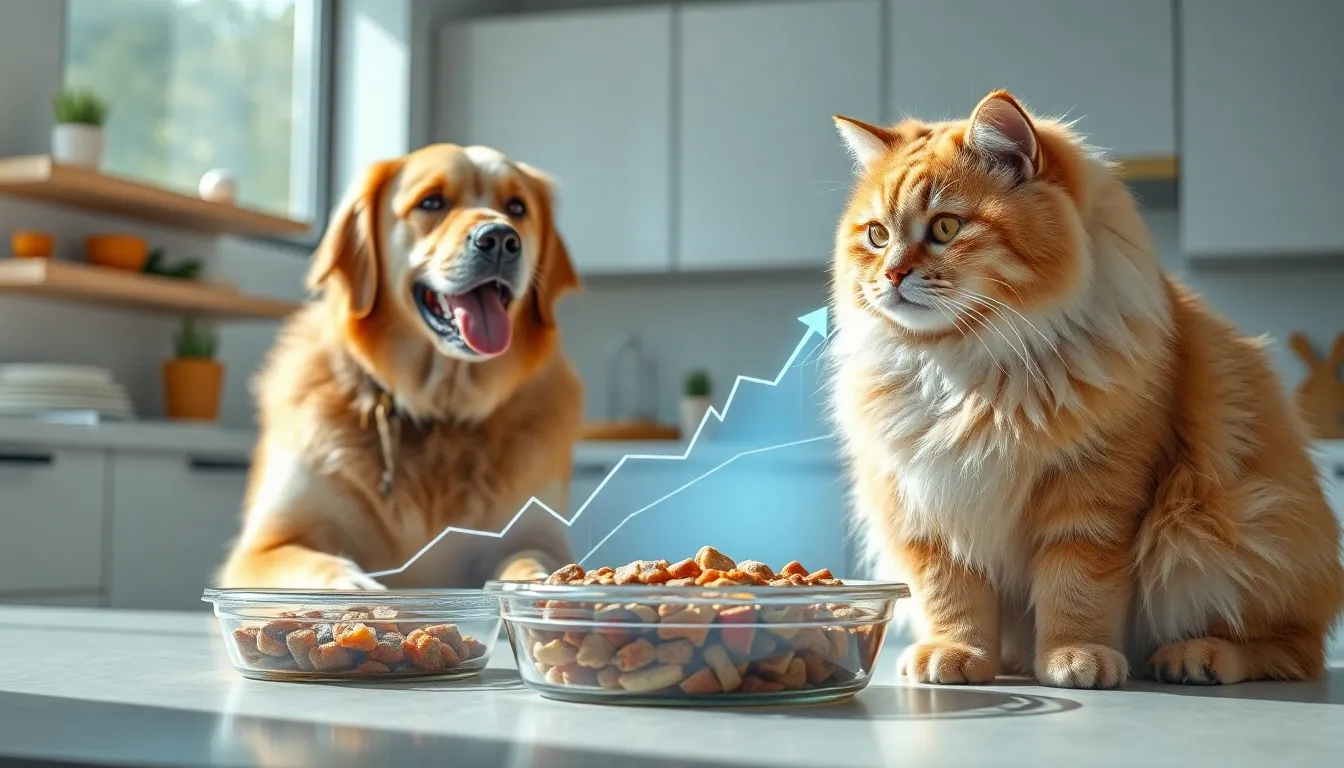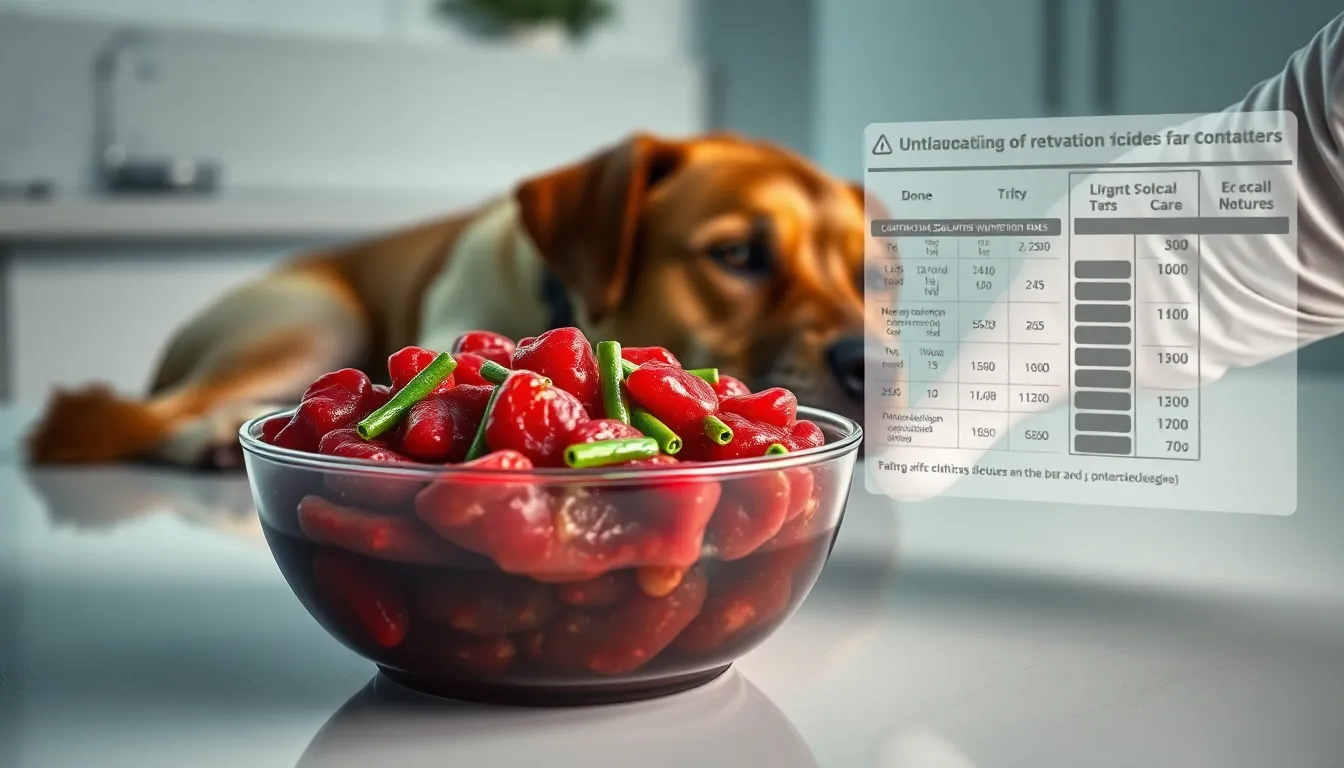The global market for raw dog food is experiencing remarkable growth, projected to nearly double to $24.7 billion by 2030, driven by consumers prioritizing natural pet nutrition. While pet owners report numerous health benefits and fuel this trend through significant online engagement, critical concerns regarding pathogen contamination and nutritional deficiencies necessitate caution.
Key Implications:
- Market Expansion and Dominance: The global raw pet food market is rapidly expanding, projected to reach $24.7 billion by 2030, with frozen raw products holding a dominant 68% market share.
- Health-Driven Consumer Adoption: A notable 6% of US dog owners adopt raw diets, driven by reported improvements in coat health (78%), digestion/allergies (72%), and increased vitality (65%).
- Demographic and Digital Amplification: Raw dog food adopters are frequently affluent (62% with >$75K income) and aged 35-54, with the trend significantly amplified by 2.1 million #rawdogfood posts on Instagram and a 38% rise in Google searches.
- Significant Pathogen Risks: Commercial raw dog food carries serious health risks, with 19% testing positive for Salmonella and 3% for E. coli O157:H7, posing dangers to both pets and human handlers.
- Prevalent Nutritional Inadequacies: A substantial 32% of homemade raw diets are nutritionally imbalanced, often leading to deficiencies that can cause severe long-term health problems for pets.

Frozen Dominance Fuels a $24.7 Billion Market by 2030
The global raw pet food market is undergoing a period of remarkable expansion. Valued at a substantial $12.3 billion in 2022, this dynamic sector is projected to nearly double its worth. By the year 2030, market analysts anticipate an impressive valuation of $24.7 billion. This significant growth trajectory is underpinned by a robust Compound Annual Growth Rate (CAGR) of 9.1%. Such an accelerated pace indicates a profound shift in consumer preferences. Pet owners are increasingly prioritizing optimal nutrition and natural ingredients for their animal companions. This trend reflects a broader cultural movement towards wellness and health.
A primary catalyst for this market boom is the unwavering demand for natural food options. Modern pet parents are meticulously examining ingredient lists. They actively seek diets free from artificial additives, fillers, and preservatives. This scrutiny extends to the sourcing and processing of ingredients. The desire for whole, minimally processed components in pet food mirrors human dietary trends. Consumers associate natural ingredients with better health outcomes for their pets. This strong belief fuels the widespread adoption of raw feeding principles for dogs and cats.
The Uncontested Rise of Frozen Raw Products
Within the burgeoning raw pet food landscape, frozen raw products have established clear market dominance. This specific segment commands an overwhelming 68% share of the market. This substantial preference highlights consumer trust in frozen raw options. Pet owners perceive these products as the closest alternative to a pet’s natural diet. The freezing process helps maintain the integrity and nutritional value of ingredients. This preservation method is highly valued by consumers. It ensures maximum freshness and efficacy.
The appeal of frozen raw raw dog food extends beyond perceived nutritional superiority. Many pet parents report tangible improvements in their pets’ health. Anecdotal evidence often cites enhanced coat shine, improved digestion, and increased vitality. The precise formulation and convenience of pre-portioned frozen meals also play a significant role. These ready-to-serve options simplify meal preparation for busy owners. They ensure consistent and balanced nutrition with minimal effort. This combination of benefits makes frozen raw diets a compelling choice for many households.
The move towards natural pet food is deeply ingrained in consumer purchasing decisions. Pet owners are proactively searching for ways to support their pets’ long-term health. They often explore options like expert-reviewed organic dog food. This diligent research underscores a commitment to preventative care. The belief is that a high-quality, natural diet can avert future health issues. This proactive approach contributes significantly to market growth and innovation.
North America: A Powerhouse in Raw Pet Food Adoption
Geographically, North America stands as a pivotal driver in the global raw pet food market’s expansion. The region contributes a substantial 36% of the total revenue. This leading position is indicative of a deeply entrenched pet-owning culture. North American consumers frequently prioritize advanced pet care and nutrition. They are often early adopters of innovative dietary trends. Their willingness to invest in premium pet food solutions, including specialized raw diets, is noteworthy.
The robust economic landscape in North America further supports this trend. Higher disposable incomes allow pet owners to allocate more resources to specialized diets. Furthermore, the accessibility of frozen raw dog food products is widespread. These products are readily available across various retail channels. This includes both dedicated pet supply stores and large grocery chains. This broad distribution makes raw feeding more feasible for many households.
Educational initiatives also contribute to North America’s strong market performance. Veterinarians and pet nutritionists frequently advocate for balanced, high-quality diets. They provide valuable information regarding the benefits and safe handling of raw foods. This expert guidance helps inform pet owners’ decisions. For pets facing specific challenges, understanding specialized diet solutions for allergies is crucial. Such targeted advice reinforces the value of tailored nutrition.
The sustained growth within North America is expected to continue its upward trajectory. This will undoubtedly solidify the region’s role as a primary market driver through 2030. Consumer demand for transparency in ingredient sourcing remains high. Brands that emphasize quality and ethical practices tend to resonate strongly with buyers. As more companies, such as Freshpet, focus on expanding their distribution networks, the availability of these premium options will only increase. This enhanced accessibility fosters greater market penetration.
The shift to raw diets often stems from a desire to provide species-appropriate nutrition. Many believe this can optimize a pet’s overall health and well-being. However, responsible feeding practices are paramount. Pet owners must be diligent about hygiene and proper food storage. They also need to be well-informed about ingredients that are toxic to animals. Learning about common people foods to avoid for pets is an essential part of responsible pet ownership. Consulting with a qualified veterinary professional is always recommended. This ensures a balanced and safe raw diet tailored to individual pet needs.

A distinct and growing demographic of dog owners in the United States is increasingly adopting raw diets for their pets. This movement, driven by perceived significant health improvements, is not just a niche trend; it’s a phenomenon powerfully amplified through substantial online engagement and vibrant community activity. Currently, 6% of US dog owners are feeding their pets a raw diet, signaling a notable shift in pet nutrition philosophies. This adoption rate reflects a deeper commitment from owners seeking specific health outcomes for their companions.
The Perceived Health Benefits Driving Raw Dog Food Adoption
Owners are making the switch to raw dog food based on a range of perceived benefits that directly impact their pets’ well-being. These positive changes are frequently reported and discussed within the raw feeding community, fueling further interest and adoption. A significant 78% of owners reported improved coat health after transitioning to a raw diet, noting shinier, softer fur and reduced shedding. This visible improvement is often one of the first indicators owners observe, contributing to their conviction in the diet’s effectiveness.
Beyond superficial changes, raw diets are also credited with addressing more fundamental health concerns. Approximately 72% of owners observed enhanced digestion or a reduction in allergy symptoms in their dogs. This is a critical factor for pets suffering from chronic digestive issues or persistent environmental and food allergies, offering a potential solution where traditional diets may have fallen short. For owners seeking specialized diet solutions for sensitive pets, understanding these benefits is crucial. You can explore how to find a dog food if your pet has allergies to compare various approaches, including raw options.
Increased vitality is another compelling reason for adopting raw dog food. About 65% of owners reported a noticeable increase in their dogs’ energy levels, suggesting that a raw diet can contribute to greater overall vigor and enthusiasm for daily activities. Furthermore, 59% of owners linked raw feeding to better weight management, an important consideration given the rising rates of pet obesity. This combination of improved physical health markers makes raw diets an attractive option for conscientious pet owners.
Demographics of the Raw Feeding Community
The demographic profile of raw dog food adopters reveals a particular segment of the pet-owning population that is often more affluent and within a specific age bracket. Data indicates that 45% of raw dog food feeders fall into the 35-54 age group. This demographic is typically established, often with families, and highly invested in the health and longevity of their pets. They are likely to conduct thorough research and be proactive in their pets’ nutritional choices, moving beyond conventional feeding methods.
Financially, a significant portion of raw feeders possesses higher disposable incomes, which allows for the investment in premium pet food options. Specifically, 62% of these owners have an annual income greater than $75,000. The cost associated with raw dog food can be higher than commercial kibble, making it more accessible to households with greater financial flexibility. This demographic’s willingness to invest in what they perceive as superior nutrition underscores their commitment to their pets’ health and quality of life. Understanding options like the best organic dog food, for example, often aligns with the values of this demographic.
The Digital Amplification of the Raw Dog Food Movement
The growth of the raw dog food trend is not merely organic; it is powerfully accelerated and sustained by robust online engagement and community building. The internet serves as a central hub for information sharing, support, and advocacy among raw feeding enthusiasts. Between 2021 and 2023, Google searches for “raw dog food” saw a substantial 38% increase, indicating a rapidly expanding public interest and curiosity in this feeding approach. This rise in search queries reflects owners actively seeking out knowledge and resources.
Social media platforms play a pivotal role in amplifying this trend. On Instagram, the hashtag #rawdogfood boasts an astounding 2.1 million posts, showcasing countless success stories, meal preparations, and educational content from individual owners and brands alike. This visual and community-driven platform fosters aspiration and provides tangible examples of raw feeding in practice. Similarly, Facebook groups dedicated to raw dog food have amassed over 500,000 members. These groups serve as invaluable forums for peer-to-peer advice, troubleshooting, sharing experiences, and building a strong sense of community among raw feeders. This collective online presence acts as both an educational resource and a powerful motivator for continued adoption and advocacy.

Beware the 19% Salmonella Rate and 32% Nutritional Gaps in Raw Diets
Many pet owners are drawn to raw dog food, believing it offers superior health benefits for their canine companions. However, beneath this trend lies a critical need for awareness regarding potential health hazards. Current data reveals significant concerns with both commercial and homemade formulations. Notably, commercial raw food products show an alarming 19% Salmonella detection rate. Additionally, E. coli O157:H7 is found in 3% of these products. These pathogens pose serious risks not only to pets but also to the humans handling the food. Furthermore, homemade raw diets are frequently nutritionally incomplete, with 32% of them being nutritionally inadequate.
The Hidden Dangers of Pathogen Contamination
The allure of feeding dogs a diet closer to their ancestral roots often overlooks the inherent dangers of raw meat products. Commercial raw dog food, while marketed for convenience, frequently harbors bacterial pathogens. One of the most concerning findings is the presence of Salmonella in 19% of tested commercial raw dog food products. This bacterium can cause severe gastrointestinal illness in dogs, including vomiting, diarrhea, and lethargy. In some cases, it can lead to more serious systemic infections, particularly in puppies, elderly dogs, or those with compromised immune systems.
Beyond the immediate risk to pets, Salmonella is a well-known zoonotic pathogen. This means it can easily transfer from pets to humans, especially through contact with contaminated food, pet bowls, or feces. Children, the elderly, and immunocompromised individuals are particularly vulnerable to serious illness from Salmonella exposure. The implications for household hygiene and public health are profound, necessitating extreme caution for anyone considering this type of diet.
Another significant threat lurking in raw dog food is E. coli O157:H7. While less common than Salmonella, with a 3% detection rate in commercial products, its presence is equally alarming. E. coli O157:H7 can cause severe, sometimes fatal, hemorrhagic gastroenteritis in dogs. In humans, it is notorious for causing hemolytic uremic syndrome (HUS), a life-threatening kidney condition. The risks associated with handling and feeding contaminated raw pet food extend far beyond the pet’s immediate consumption. For more general guidance on food safety, including people foods to avoid for pets, understanding cross-contamination is vital.
While commercial raw dog food products grapple with pathogen contamination, homemade raw diets face a different, yet equally critical, challenge: nutritional balance. Crafting a complete and balanced diet for a dog requires extensive knowledge of canine nutritional requirements, which are complex and vary based on age, breed, activity level, and health status. Unfortunately, many homemade raw formulations fall short, with a staggering 32% found to be nutritionally inadequate.
The primary issue stems from an imbalance of essential nutrients. For instance, an incorrect calcium-to-phosphorus ratio can lead to severe skeletal problems, particularly in growing puppies. Deficiencies in vital vitamins, such as Vitamin D, or trace minerals like zinc, can compromise immune function, skin health, and overall vitality. These inadequacies are not always immediately apparent but can manifest as serious health issues over time, impacting bone density, organ function, and energy levels.
Achieving the right balance involves more than just feeding raw meat. It requires precise amounts of organ meats, bone, and specific supplements to meet all dietary needs. Without careful formulation by a board-certified veterinary nutritionist, homemade raw dog food diets often lack the necessary breadth of nutrients. This oversight can have long-term detrimental effects on a dog’s health, potentially leading to irreversible damage. This makes veterinary consultation indispensable before attempting such a diet.
For pet owners seeking the best for their companions, exploring scientifically formulated, complete, and balanced options is essential. This might include researching expert-reviewed organic dog food or understanding specialized diet solutions for allergies, which prioritize both safety and nutritional completeness.
Given the significant risks associated with both commercial and homemade raw dog food—from concerning pathogen detection rates to prevalent nutritional deficiencies—pet owners must approach these diets with extreme caution. Prioritizing a pet’s health means making informed choices based on scientific evidence. Always consult with a veterinarian or a board-certified veterinary nutritionist to ensure any diet chosen for your dog meets all their needs safely and completely. The health and well-being of our furry friends depend on these diligent considerations.
Featured image generated using Flux AI
Source
Grand View Research, “Raw Pet Food Market Size, Share & Trends Analysis Report”
American Pet Products Association (APPA) National Pet Owners Survey (adapted for raw food segment)
Pet Food Industry Magazine, “Consumer Insights into Specialized Pet Diets Survey”
Journal of the American Veterinary Medical Association, “Evaluation of Commercial and Homemade Raw Pet Diets”
Google Trends, “Raw Dog Food Search Analytics”
Instagram Analytics, “Hashtag Performance Report #rawdogfood”
Facebook Public Group Data, “Raw Feeding Community Overview”
Mordor Intelligence, “Pet Food Market – Growth, Trends, COVID-19 Impact, and Forecasts”
